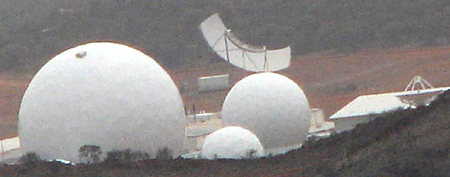Sir – In 1985, the Northern Territory Branch of the Medical Association for Prevention of War (MAPW) issued a research paper titled: “What will happen to Alice if the bomb goes off ?”- the consequences for Alice Springs of a nuclear explosion over the Joint Defence Facility Pine Gap.
My wife and I and my daughter will be attending the the Independent and Peaceful Australia Network (IPAN) conference and Pine Gap protests in September in Alice, hence our interest in these matters.
(IPAN, according to its website, is a network of organisations from all regions of Australia who are united by support for an independent Australian foreign policy based on peaceful resolution of conflicts. – ED)
[The MAPW paper] was based on the assumption of a one megaton bomb being detonated one kilometer above Pine Gap which would inflict maximum damage.
It states that the blast would have maximum effect within 15 km of ground zero and that the MacDonnell Ranges would block and lessen the effects of the blast on the Alice Springs town. However most windows in town would be shattered and there would be danger from flying glass.
The electromagnetic pulse (EMP) would stop everything dependent on electricity: lights, cars, telephones, radios and TV’s and computers would all cut out.
The flash would blind everyone up to a distance of 80 km away who was looking in the direction of the flash at the moment of the explosion or, who, noticing the flash, instinctively glanced towards it.
The effects of the heat released by the explosion would extend to 15 to 20 km. Similar to the blast, most damage would occur outside Heavitree Gap but parts of the airport road, Stuart Highway, Larapinta Dv, the Ranger’s Station at Simpson’s Gap and all scrub and animal life within a 10 km radius would catch fire.
The effects of radiation released by the blast would depend on wind direction. Radiation reaching the town would probably not be lethal and would arrive the day after; it might be sufficient to cause bone marrow suppression and gastrotestinal effects.
Prof. Richard Tanter (Nautilus Institute) states in his updated 2012 document on Pine Gap: “However none of this [the risks to population] has ever been publicly conceded by a government in office. Nor has there ever been a serious attempt to explain to people living in towns close to these targets the dangers they face. And no Australian government made a serious attempt at civil defence preparations for the populations of near these bases.”
If it wasn’t for the United States pulling Australia through the US-Australia Alliance into a confrontation with potential hostilities with China, there would be no point in discussing this subject.
But since Pine Gap has become a major US military communications facility which strategists claim would be vital to the US in a war in our region and China has nuclear missiles capable of reaching Pine Gap, this issue demands attention.
Adding emphasis to this danger is journalist David Uren’s critique of defence policy in which he reports a “secret appendix” to the 2009 Defence White Paper stating: “Defence thinking is that in the event of a conflict with the United States, China would attempt to destroy Pine Gap.”
US and CIA personnel at Pine Gap may help the Alice Springs economy with dollars but are the dollars worth the risk ?
Bevan Ramsden
Lambton, NSW
